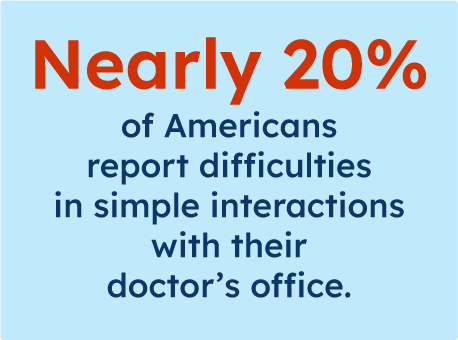Do you ever wonder how happy your patients are?
Recently, I found myself deep in the world of online reviews while buying a phone case and a dog brush on Amazon. Before I placed my order, I read nearly a zillion reviews of each product and then I read even more reviews about competing products. (I might be exaggerating just a little. In reality, I read 15 or so reviews of each item, but it did take quite a bit of time to conduct this research.)
While I spent less than 20 dollars in total, the reviews I read greatly influenced my purchase decisions. If others were happy with the product, then I decided I would be, too. Customer reviews are that powerful.
The same goes for healthcare organizations and patient satisfaction. The time and effort I put into analyzing products like a self-cleaning dog brush and a liquid silicone phone case are just a glimpse of the research I would conduct when choosing healthcare providers like a primary care physician, an orthopedic specialist, or an optometrist.
My experience is an example of just one of the many reasons you should be concerned with patient satisfaction. Happier patients mean better outcomes, higher patient retention, more referrals, and increased revenue. That’s why understanding and continually assessing how satisfied your patients are with the care they receive and their overall experience is essential for the success of your healthcare practice.
Why Is Patient Satisfaction Important?
While it’s always been a critical factor, in today’s patient-centered healthcare environment, patient satisfaction is gaining even more significance. Patients are increasingly seeking an active role in managing their health and expect a higher level of dedication and personalized care from healthcare providers. The shift towards patient empowerment makes patient satisfaction a critical component of healthcare delivery.
Moreover, the evolution towards value-based care models further underlines the importance of patient satisfaction. You’re now expected to meet both financial objectives and patient-centric goals, demanding both clinical excellence and a commitment to ensuring positive patient experiences.
Also, patient satisfaction directly influences patient loyalty and the reputation of a healthcare practice. Nearly 20% of Americans report difficulties in simple interactions with their doctor’s office, such as scheduling appointments, asking questions, or accessing lab results. If patients aren’t happy with your services, they’ll switch to competitors and probably share negative feedback about their experiences.
happy with your services, they’ll switch to competitors and probably share negative feedback about their experiences.
On the other hand, patients who have exceptional experiences are more inclined to return for future care and recommend your practice to others, influencing its reputation and contributing to increased revenue and profitability.
How to Measure and Improve Patient Satisfaction?
In a healthcare setting where patient expectations are constantly evolving, and the market is increasingly competitive, it’s essential to actively work on improving patient satisfaction. Here are some of the steps you can take to enhance patient well-being and the growth of your healthcare practice:
Adapt Communication to Patient Preferences
Today’s patients want clear, convenient communication with their healthcare providers in the method they prefer. This means asking patients if they want a phone call, email, or text. More than ever, the trend is moving toward digital communications. Even before the pandemic launched technology forward faster than anyone could have predicted, people of all ages were comfortable interacting online, via email, and text messages.
It’s important to keep patients informed of upcoming appointments, test results, office closings, or changes in protocol in a way that’s convenient for them. Something as simple as noting patient communication preferences can improve satisfaction exponentially.
Embrace a Patient-Focused Approach
Do you offer convenient hours for doctor’s appointments? Do you schedule time to really listen and get to know each patient? Each person who visits your practice wants to be treated as an individual with important health concerns. Take the time to understand their needs and make the appointment all about them.
Make sure your office staff is friendly, patient, and sociable so families feel welcomed from the moment they walk in the door. Everyone’s favorite healthcare teams are the ones who greet us with a smile, have a sense of humor, and make us feel like part of their extended family each time we visit the office for routine care or a specific concern.
Use Surveys to Understand Patient needs and Level of Satisfaction
 After each visit, send a customized patient survey to gather valuable feedback—especially for areas that need improvement.
After each visit, send a customized patient survey to gather valuable feedback—especially for areas that need improvement.
Patient surveys should comprehensively cover various aspects of the patient experience. This includes evaluating wait times, assessing the quality of medical care, gauging the friendliness and responsiveness of staff, and examining the convenience of scheduling appointments. By addressing these key areas, you can get valuable insights into the patient’s perspective.
The feedback obtained from these surveys helps in identifying specific areas that require improvement, as well as acknowledging and reinforcing the strengths of your practice. Moreover, regularly analyzing survey data allows you to track improvements over time and make data-driven decisions to improve patient satisfaction.
Encourage Satisfied Patients to Leave Positive Reviews
More positive reviews mean more new patients for your healthcare organization and physicians. So, how do you get your happiest patients to leave a review in the first place?
Encourage them to share their experiences by sending automated review requests within 24 hours of their visit because their recent experience and satisfaction will make them more likely to provide feedback. Also, make sure that these automated messages are personalized and express gratitude for their visit to increase the sense of connection.
To increase patients’ participation, include a direct link to the review platform in your message, and provide clear, simple instructions on how to leave a review. Reducing the number of steps and making the process as effortless as possible can significantly boost the number of reviews you receive. It’s also beneficial to explain to patients how their reviews can help others seeking similar care. Knowing that their feedback could positively impact someone else’s healthcare choices can be a strong motivation for patients to share their experiences.
Understand Patient Experience through Demographics
Once you’ve implemented patient reviews and surveys, and you’re making an effort to improve patient satisfaction, gather more insight beyond this data. With the right tools, you can filter feedback from diverse patient groups, individually, or in combinations that include age, gender, race, language preference, and other criteria.
This detailed analysis enables you to grasp the diverse needs and experiences of different patient categories and uncover specific trends and preferences that might not be immediately apparent. In addition to more targeted improvements in patient care and communication strategies, this allows you to create a more inclusive and responsive healthcare environment that caters to the unique needs of all patient groups.
Make Patient Satisfaction the Foundation of Success
Becoming a top-rated healthcare practice starts when you decide to make patient satisfaction a priority. Every step you take in this process benefits the patients and contributes to the growth and reputation of your healthcare organization.
With the right strategies, you can create a positive, nurturing, and inclusive environment where patients feel valued and heard. This will not only lead to better health outcomes but also foster a loyal patient base, enthusiastic online reviews, and a reputable position in the healthcare community.
To support your journey in making patient satisfaction a foundation of success, SocialClimb offers innovative solutions tailored to your needs. Our comprehensive healthcare marketing platform seamlessly integrates with your practice management system, automating essential processes while ensuring HIPAA compliance for data security.
Whether you need straightforward survey creation and delivery, automated review management, or advanced demographic insights, features within our platform are designed to help you better understand and respond to your patients’ needs, while improving patient satisfaction and growing your healthcare organization.











